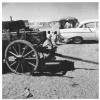The persistence of American Indian health disparities
- PMID: 17077399
- PMCID: PMC1698152
- DOI: 10.2105/AJPH.2004.054262
The persistence of American Indian health disparities
Abstract
Disparities in health status between American Indians and other groups in the United States have persisted throughout the 500 years since Europeans arrived in the Americas. Colonists, traders, missionaries, soldiers, physicians, and government officials have struggled to explain these disparities, invoking a wide range of possible causes. American Indians joined these debates, often suggesting different explanations. Europeans and Americans also struggled to respond to the disparities, sometimes working to relieve them, sometimes taking advantage of the ill health of American Indians. Economic and political interests have always affected both explanations of health disparities and responses to them, influencing which explanations were emphasized and which interventions were pursued. Tensions also appear in ongoing debates about the contributions of genetic and socioeconomic forces to the pervasive health disparities. Understanding how these economic and political forces have operated historically can explain both the persistence of the health disparities and the controversies that surround them.
Figures




Comment in
-
Existence of Alaska Native health disparities.Am J Public Health. 2007 Sep;97(9):1541-2; author reply 1542-3. doi: 10.2105/AJPH.2007.115006. Epub 2007 Jul 31. Am J Public Health. 2007. PMID: 17666681 Free PMC article. No abstract available.
References
-
- Howard S. Russell, Indian New England Before the Mayflower (Hanover, NH: University of New Hampshire Press, 1980), 35, 104–105; Douglas H. Ubelaker, “Patterns of Demographic Change in the Americas,” Human Biology 64 (June 1992): 364; Clark Spencer Larsen, “In the Wake of Columbus: Native Population Biology in the Postcontact Americas,” Yearbook of Physical Anthropology 37 (1994): 109–154.
-
- For discussions of the poor-health of pre-Columbian populations, see the many excellent chapters in Richard S. Steckel and Jerome C. Rose, The Backbone of History: Health and Nutrition in the Western Hemisphere (Cambridge: Cambridge University Press, 2002). For a detailed discussion of 1 urban population, see Rebecca Storey, Life and Death in the Ancient City of Teotihuacan: A Modern Paleodemographic Synthesis (Tuscaloosa: University of Alabama Press, 1992), 253–266.
-
- Larsen, “In the Wake of Columbus,” 109–154; Rebecca Storey, Lourdes Marquez Morfin, and Vernon Smith, “Social Disruption and the Maya Civilization of Mesoamerica: A Study of Health and Economy of the Last Thousand Years,” in Steckel and Rose, Backbone of History, pp. 283–306; Douglas H. Ubelaker and Linda A. Newson, “Patterns of Health and Nutrition in Prehistoric and Historic Ecuador,” in Steckel and Rose, Backbone of History, pp. 343–375; S. Ryan Johansson and Douglas Owsley, “Welfare History on the Great Plains: Mortality and Skeletal Health, 1650 to 1900,” in Backbone of History, ed. Steckel and Rose, pp. 524–560; Steckel and Rose, “Patterns of Health in the Western Hemisphere,” in Backbone of History, pp. 563–579.
-
- Henry F. Dobyns, “Estimating Aboriginal American Population: An Appraisal of Techniques with a New Hemispheric Estimate,” Current Anthropology 7 (October 1966): 395–416; Ubelaker, “Patterns of Demographic Change in the Americas,” 361–379; Michael H. Crawford, The Origins of Native Americans: Evidence from Anthropological Genetics (Cambridge: Cambridge University Press, 1998), 33–39; David Henige, Numbers from Nowhere: The American Indian Contact Population Debate (Norman: University of Oklahoma Press, 1998).
-
- “Estimates of the precontact population of Hispanola have ranged between 60000 and nearly 8000000.” Noble David Cook, Born to Die: Disease and New World Conquest, 1492–1650 (Cambridge: Cambridge University Press, 1998), 22–23. The best available evidence has narrowed the range to between 100000 and 400000. Massimo Livi-Bacci, “Return to Hispanola: Reassessing a Demographic Catastophe,” Hispanic American Historical Review 83 (2003): 3–51.
Publication types
MeSH terms
LinkOut - more resources
Full Text Sources

